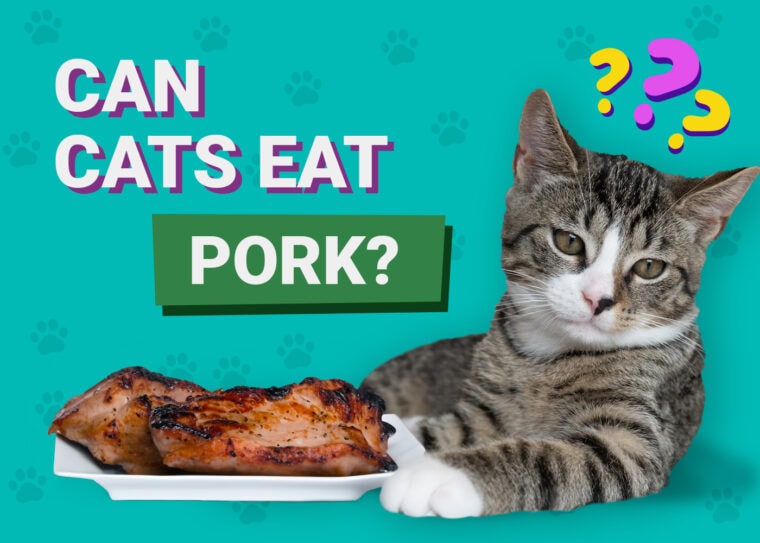
When your cat has perfected a mean begging face, it can be hard to resist sharing your dinner or snacks with your feline friend. If your cat frequently tries to steal your breakfast bacon, you might wonder whether it’s okay to let them eat it. While cats can safely eat some pork products, others are unhealthy and should be avoided.
In this article, we’ll go into more detail about whether pork is okay for cats, which types should be avoided, and why. We’ll also discuss how to safely prepare and feed pork to a cat, including how it fits into a healthy diet.
What Pork Is Okay for Cats to Eat?
If you want to feed your cat pork, stick with unprocessed, lean cuts of meat like pork chops, ribs, or tenderloin. Pork is a good source of protein, B vitamins, and other essential nutrients for cats.
It is an uncommon ingredient in commercial cat food and may be a good option for cats with suspected food allergies. It is generally easily digested, but unfamiliar food may upset your cat’s stomach.

What Pork Products Should You Avoid Feeding Your Cat?
As you might have guessed from the previous section, you should generally avoid feeding processed pork products to your cat. This includes sausage, ham, and, yes, bacon. They are certainly appealing to your cat, but the full flavor comes with a price.
Processed pork products usually contain too much salt, fat, and preservatives. They may also contain ingredients dangerous to cats, such as garlic and onions. Even non-toxic spices and other ingredients could upset your cat’s stomach.
Eating too much salt isn’t healthy for cats and can even be toxic in high enough quantities, but salt toxicity is incredibly rare and is unlikely to occur. Consuming excessive fat can cause your cat to gain too much weight. Obesity in cats can lead to multiple health complications, including joint problems, diabetes, and heart issues.
Safety Tips When Feeding Your Cat Pork
If you’re feeding your cat pork, there are a couple of important safety tips to follow besides choosing healthy products

How Much Pork Can Your Cat Eat?
Unless your cat is eating a homemade pork-based diet under the guidance of a veterinarian, pork should be considered a treat. Treats should make up no more than 10% of your cat’s daily calorie intake. Ask your vet for help determining how many calories your cat should eat per day.
Most of these calories should come from nutritionally balanced cat food. Cats require specific vitamins, minerals, and amino acids to stay healthy. Plain pork, while it can be nutritious, won’t supply these in the appropriate quantities.
For the same reason, you should never feed your cat a homemade diet with pork or any other protein without consulting your veterinarian. A veterinarian or veterinary nutritionist should formulate homemade diets to ensure they are balanced.
Knowing exactly what your feline companion can and cannot eat will help you become the best pet parent. Recognizing that not all cat bowls are equal is also key! The Hepper NomNom Cat Bowl sets itself apart from traditional options by catering to the specific needs of cats. The innovative design offers whisker relief via shallow dishes and promotes digestion with a slight bowl elevation. Find out if the Hepper NomNom is right for your cat by clicking here.
At Pet Keen, we’ve admired Hepper for many years and decided to take a controlling ownership interest so that we could benefit from the outstanding designs of this cool cat company!
In Conclusion
While cats can eat some types of pork, processed products, such as bacon and ham, should be avoided. If you feed your cat pork, ensure it’s free of bones and cooked to a safe temperature, just as you would for yourself. Be cautious when introducing any new food to your cat for the first time, including pork. Start with a small amount and monitor for any signs of a digestive upset, such as vomiting or diarrhea. And remember, just because you can feed your cat pork doesn’t mean you have to. It’s okay to stick to a balanced diet of high-quality cat food.
Featured Image Credit: Lebensmittelfotos, Pixabay









